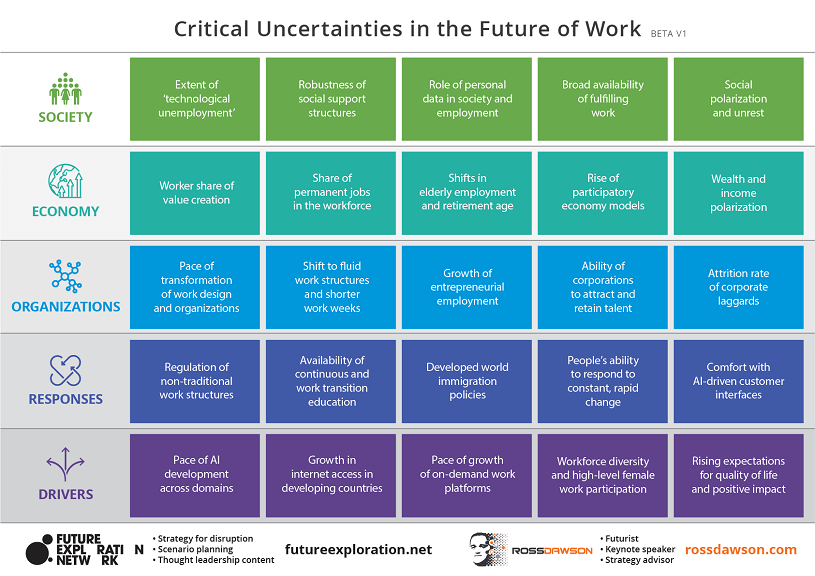New Framework: Critical Uncertainties in the Future of Work
This morning I gave a keynote at the Association of Asia-Pacific Business Schools Annual Conference, which brings together the Deans and leaders of the top business schools in the region.
The other sessions in the morning were presented by McKinsey & Co and PwC, so I wanted to present perspectives that would be complementary to their analysis.
For any structured analysis of the future, we need to understand on the one hand trends and driving forces, and on the other critical uncertainties. There has been extensive discussion of the forces shaping the future of work, but I don’t believe there has been sufficient critical analysis of the uncertainties.
My keynote covered the broad scope and context for the future of work, however I centered it around the uncertainties that we need to consider in understanding how the world of work may evolve from here. To do this I shared a framework I have recently developed of these uncertainties, shown below.

Click on the image for full-size pdf
It is worth making a few comments to amplify on the content in framework. The framework should be read from the bottom layer, building from the foundational elements to the broadest levels of impact.
Drivers
There are a number of key driving forces shaping the future of work. However each of these drivers also have significant uncertainties, notably in the speed and extent of these trends, and in some cases whether they may change in nature.
For example, AI is a set of technologies, and while we know we cannot accurately anticipate the overall pace of development, we also have the potential for some of the specific domains and applications of AI to progress faster or slower, differentially impacting tasks, jobs, and workforce automation. While increasing expectations for quality of life and positive impact are very powerful drivers today, if work becomes highly disrupted, expectations may retreat substantially for people to become satisfied with reasonable work and income rather than continuing to expect more.
Responses
The responses – or potentially the lack of effective responses – to shifts in work will be critical, and will result in substantial differences to the work landscape across jurisdictions. In some countries regulatory responses are beginning to address the realities of the ‘gig economy’. Arguably even more important is the establishment of education and support structures to facilitate what could be challenging and extensive workforce transitions. These will be critical to enable the scope of change that is likely to be required in coming years.
Other critical uncertainties include the population’s broad-based capacity to respond positively to change, in underlying attitudes and in action, including self-directed education. Automation is highly likely to impact process work and vehicle operation, however its impact on customer service roles such as call centers and fast food service depends on how readily people accept substantially reduced human interaction in customer service.
Organizations
It is clear that some organizations will respond better to a swiftly changing environment than others, however a key question is whether this will heighten the existing divergence in performance between companies, with the potential for very high attrition rates for laggards.
Underlying this are uncertainties on how quickly existing work structures, such as the five-day work week, may change, and the pace of growth in entrepreneurial employment, which may contribute to strong challenges for corporations larger in attracting the talent they need to succeed.
Economy
Uncertainties are rife at the level of the economy. Over the last two decades there has been a substantial decrease of labor’s share of national income across most OECD nations. The continuation or reversal of this trend points to very different work markets, and the potential for the accentuation of the already strong recent polarization of wealth and income in developed nations.
Economic structural issues include the share of permanent versus contingent workforce, and changes in retirement age and work, which could be substantial. There is also the possibility of the development of participatory economy models, for example co-operative platforms, which could allow greater participation and value extraction by workers.
Society
One of the biggest uncertainties and one which has been perhaps the biggest focus for many is the degree of ‘technological unemployment’ resulting from automation. There are dramatically different outlooks on this single issue from across respected observers; where this goes is fundamentally uncertain. The degree of social polarization and potential unrest in the case of large-scale disruption is also impossible to predict.
Other key uncertainties include whether Universal Basic Income or similar social support structures are implemented, how broadly fulfilling work is available, and the degree to which personal data plays a role in society and in particular in the workplace, impacting the very nature of the employer-employee relationship.
Applying the framework
These are of course not the only uncertainties in the future of work, but some of the most important as we plot our course forward.
I have taken a macro perspective as all participants – be they employers, regulators, educators, workers or others need to be framing the context for their decisions in the first instance at this level. From this more specific organization-specific strategies can be developed and implemented.
Mapping uncertainties is not valuable on its own. The intention of this framework is to enable the deep structured thinking about the future of work that is required by organizations and business leaders to take these fundamental uncertainties into account in strategy development, leading to better decision-making and a more robust path to a positive future of work.
Image: Daniel Dionne



